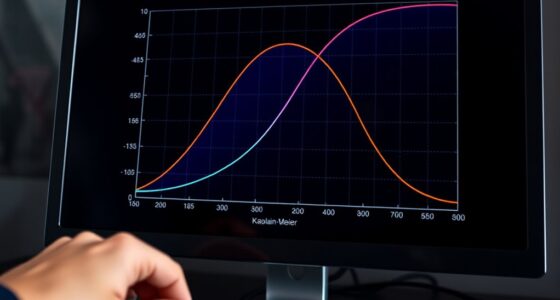The Shapiro–Wilk test helps you check if your data follows a normal distribution, which is important for many statistical methods. You input your data, and the test gives you a p-value. If the p-value is below 0.05, your data likely isn’t normal; if it’s above, it probably is. Keep in mind, sample size and outliers matter. Curious about how to interpret the results accurately? There’s more to discover as you explore further.
Key Takeaways
- The Shapiro–Wilk test checks if data follows a normal distribution, especially useful for small to moderate sample sizes.
- A p-value above 0.05 suggests data is normally distributed; below 0.05 indicates deviation from normality.
- It assumes data points are independent and free from outliers for accurate results.
- The test is sensitive to sample size; large samples may flag minor deviations as significant.
- Use the test results alongside other distribution checks for a comprehensive assessment.

Have you ever wondered whether your data follows a normal distribution? Understanding this is vital because many statistical tests rely on the assumption of normality. The Shapiro–Wilk test is a popular method for checking this, especially when you’re working with smaller datasets. It’s designed to evaluate the distribution assumptions, helping you decide if your data is approximately normal or if you need to consider alternative approaches. One key aspect to keep in mind is sample size considerations. The Shapiro–Wilk test is most reliable with small to moderate sample sizes, typically up to 50 or 60 observations. As your sample size grows larger, the test becomes more sensitive, sometimes flagging minor deviations from normality that may not be practically significant. This means you should interpret results carefully, especially with large datasets, because the test might suggest non-normality even when your data is sufficiently normal for practical purposes.
When using the Shapiro–Wilk test, you’re fundamentally evaluating whether your data aligns with the normal distribution’s shape. If the test produces a p-value below your chosen significance level, usually 0.05, it indicates that your data likely doesn’t follow a normal distribution. Conversely, a p-value above this threshold suggests no evidence against normality, meaning your data could be normally distributed. This straightforward decision-making process makes the test user-friendly, but you need to remember that statistical significance doesn’t always equate to practical significance. Small deviations detected in large samples might not matter much in real-world applications, so consider the context and the purpose of your analysis.
It’s also important to understand the assumptions underlying the Shapiro–Wilk test. The primary assumption is that the data are independent and identically distributed, that is, each data point should be independent of the others. Violating this assumption can lead to misleading results. Before applying the test, you should verify that your data meets these conditions and is free from outliers, as extreme values can also influence the test outcome. In some cases, you might need to preprocess your data—such as removing outliers or transforming variables—to get a clearer picture of its distribution.
Frequently Asked Questions
Can the Shapiro–Wilk Test Handle Large Sample Sizes Effectively?
You might wonder if the Shapiro–Wilk test handles large sample sizes effectively. While it’s known for high accuracy with small to moderate samples, it does face some sample size limitations. As your sample grows, the test can become less computationally efficient, making it slower or less practical. For very large datasets, consider alternative tests better suited for handling extensive data without sacrificing performance.
How Does the Test Perform With Skewed or Multimodal Data?
You might wonder how the test performs with skewed data or multimodal distributions. It tends to be less reliable in these cases because it assumes normality. When your data is skewed or multimodal, the test might incorrectly suggest non-normality, even if the data isn’t fundamentally abnormal. For more accurate results, consider alternative methods like the Anderson-Darling test or visual checks, especially with such complex data patterns.
Are There Alternatives to the Shapiro–Wilk Test for Normality?
Did you know there are over 20 tests for checking normality? When your data challenges normality assumptions, you might consider alternatives like the Anderson-Darling, Kolmogorov-Smirnov, or Lilliefors tests. These tests can be more suitable depending on your data distribution, especially if your data is skewed or multimodal. Exploring these options helps guarantee your analysis is valid and reliable, no matter what your data looks like.
What Are Common Pitfalls When Interpreting the Test Results?
When interpreting the test results, you should watch out for sample size effects, as small samples can lead to misleading conclusions, and large samples might detect trivial deviations from normality. Also, be cautious with p-value interpretation; a significant p-value doesn’t necessarily mean your data isn’t approximately normal, nor does a high p-value confirm perfect normality. Always consider the context and complementary methods alongside the p-value.
How Does the Significance Level Affect the Test’s Outcome?
Ever wondered how significance levels influence your test results? When you set a lower alpha significance, you’re more cautious, making it harder to reject the null hypothesis. Conversely, a higher alpha increases the chance of rejecting it, even if the p value interpretation suggests otherwise. Your choice of significance level directly impacts the outcome, guiding how confidently you interpret the p value and determine if your data is normally distributed.
Conclusion
Now that you know how the Shapiro–Wilk test works, you’re better equipped to assess your data’s normality confidently. It’s straightforward and reliable for small to moderate sample sizes. But ask yourself—do you really want to proceed with analysis without verifying your assumptions? Using this test helps you make informed decisions and ensures your results are valid. So, why not make the Shapiro–Wilk test a regular part of your data analysis toolkit?










